Pilots who have attended the Aero Friedrichshafen show in Germany may have spotted Pegaso since it first exhibited in 2018. Six years later, the model lacks American representation so Yankee pilots generally don’t know this flying machine.
 This is Pegaso, a European “ultralight” that expresses a beautiful style we expect from Italy.
This is Pegaso, a European “ultralight” that expresses a beautiful style we expect from Italy.
Promecc is better known for their low-wing Sparviero but Pegaso drew lots of admiring looks at Aero 2023.
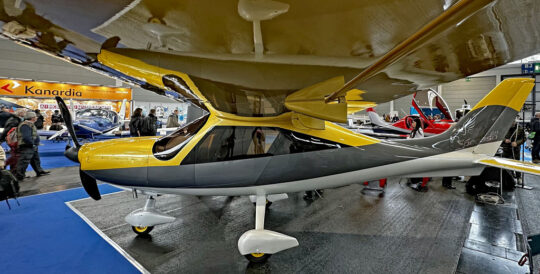
Promecc Pegaso — a Mosaic entry to be?
Let’s take a deeper look at an aircraft that can help imagine what we’ll see as Mosaic emerges from FAA rule making in the second quarter of 2025.
Promecc Pegaso
Promecc Aerospace specializes in the design and manufacture of European-style ultralight aircraft predominantly using carbon fiber construction. As is more common in Europe, the company behind Pegaso and Sparviero has a larger operation involved in professional aviation.
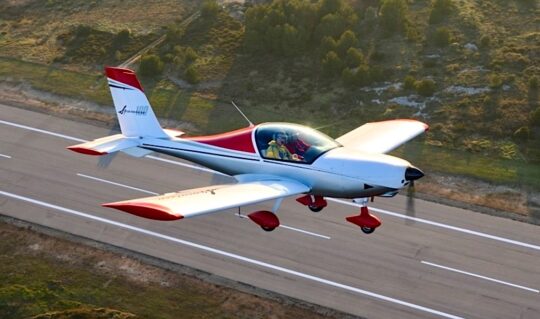
Promecc Sparviero is their entry level low wing as pictured. They make a faster version called Freccia that has retractable gear.
The company’s first design, Sparviero, which translates to Sparrowhawk in English, was introduced in the early 2000s.
This low-wing design evolved into the faster Freccia Anemo (in English: Fast Arrow) that was introduced in 2011, with a new wing design and aerodynamic refinements that produced a cruise speed of 260 kilometers per hour (140 knots) on 100 horsepower.
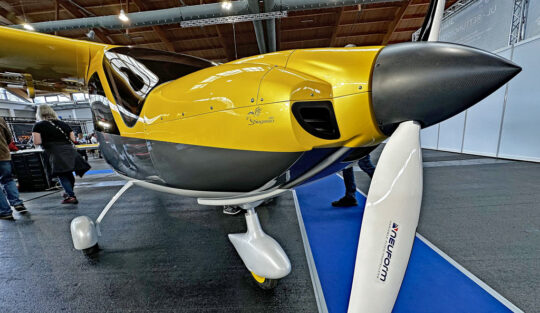
Pegaso offers now a new, more ergonomic interior and Marino reported it was “ready for series production.” Its access doors are now front-hinged, “making cabin entry much easier,” he added.
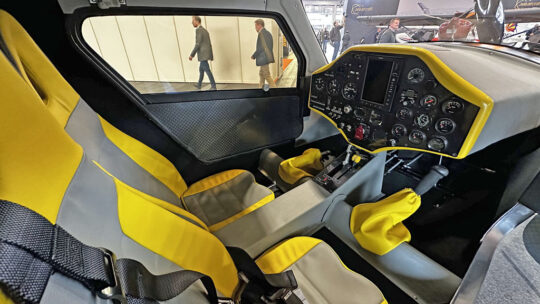
In addition to the Rotax 912 and Rotax 914 turbo, the newer Freccia RG has under the cowling the more powerful Rotax 915iS. As Marino heard from company owner Mauro Dono at Aero 2022, the event was “terrific good” with several sold aircraft. It was not reported if Promecc plans to add the 915iS or (more increasingly, designers say) Rotax’s newest 160 horsepower 916iS. To my eyes, the Pegaso could easily accommodate the larger engine in its long, spacious nose cowling (nearby image).
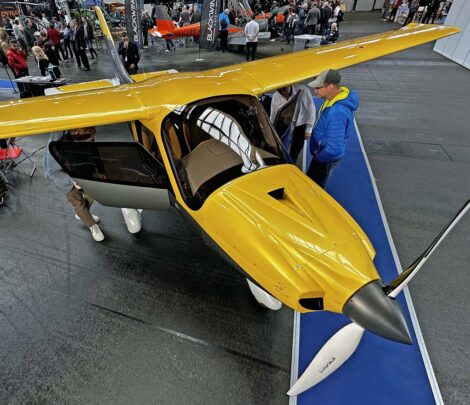
Marino reported that they intend to offer to the U.S. public the full range of aircraft as factory built but also as “price-competitive” kits.
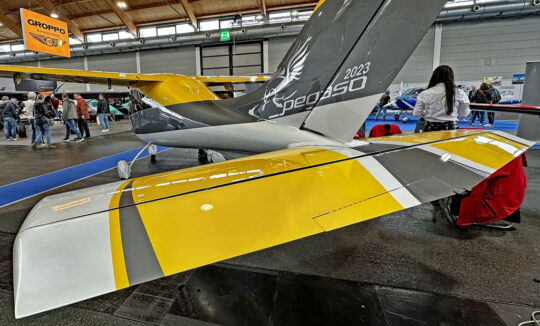
What may be most interesting is the potential for those relatively modest kit prices to translate into more affordable factory built prices once American representation is secured.
Here’s how Promecc describes the technical qualities of Pegaso:
- Fuselage is made of carbon fiber and resin certified for aviation industry
- Wing spar and every structural support are completely made of carbon fiber
- Painted with two-component polyurethane varnish, very resistant to UV rays
- Undercarriage is strong and flexible and made of composite materials
- Cockpit is spacious, ergonomic with a sporty finish
- Side-by-side ergonomic seats
- Cockpit is yet comfortable setting and offers excellent visibility
- Plexiglass canopy is available in transparent or with blue tint
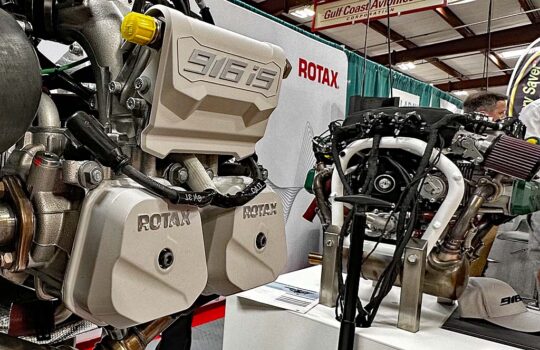
How would Pegaso perform if Promecc engineers could fit the potent Rotax 916iS? The 160 horsepower engine has many designers planning installation.
With only 100 horsepower, Pegaso can achieve a cruise speed of 255 kilometers per hour (138 knots). Never exceed speed is 300 kilometers per hour (162 knots). Pegaso’s cantilevered wing construction may not allow Mosaic weight capability (up to approximately 3,000 pounds is expected) but its sleek lines assure it can slip through the air smoothly.
Qualify Pegaso to ASTM standards with Rotax’s potent 916iS and the Italian producer could have a Mosaic candidate on their hands. Of course, this still leaves the not-trivial challenge of establishing a distribution beachhead in the world’s largest aviation market. That’s an effort yet to be determined.
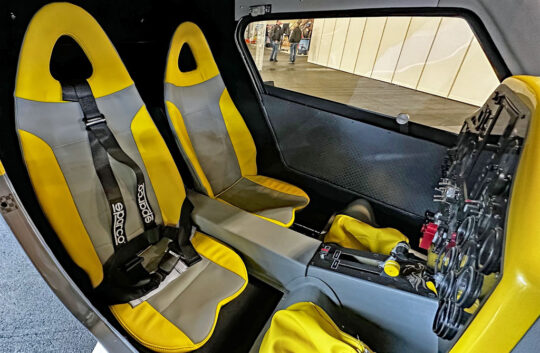
This combination of attributes could give the Italian company market entry into the world of Mosaic and what a beautiful shape they bring to the fleet.
TECHNICAL SPECIFICATIONS:
all data supplied by the manufacturer
- Maximum Takeoff Weight — 1,320 pounds
- Maneuvering Speed — 98 knots
- Stall Speed — 38 knots
- Cruise Speed — 119 knots
- Takeoff Roll — 490 feet
- Landing Distance — 720 feet
- Fuel Capacity — 2 wing tanks holding 14.5 gallons each
ARTICLE LINKS:
- Promecc Aerospace, all contact info and content on this website
- Aero Friedrichshafen, a favorite European airshow celebrating its 30th birthday in 2024


there seems to be 2 camps of high wing sport aviation. Either STOL madness or the pendulum swing to the very handsome entries as Pegaso (Picaso?). It’s interesting to me that Jabiru seems so overlooked. When one steps up to a Jabiru one realizes how low and sleek the aircraft really is. Plus much is being done with supercharging the great 3300. LSA does not only outperform the stove bolt Cessna’s and Piper’s but can display quite the fashion parade down the taxi way. The powertrain innovation is the most amazing and fun to watch and now with the evolutionary prop that looks like an infinity symbol is nothing short of inspiration. What a great industry, now if I can just find Chip Erwin’s number again, I’ve just got to build one of these things.
Will Green
I hope to have a Jabiru update sometime (probably after) Sun ‘n Fun 2024. However, you puzzled me with the Chip Erwin reference. He has nothing to do with Jabiru but you can contact either company: Jabiru USA — AeromarineLSA (Chip’s enterprise)
The Pegaso is a beautiful design. I wish them success, and appreciate the fine article.
Chip Erwin has the only “affordable” kit…
Do we have a ball park figure U.S. price range non-kit?
Not before they have U.S. operations but you can contact the company about a kit.
Looks Great
??$$
I want one.
In the end, I suspect this will be another $300K + airplane with an empty weight of less than 450lbs and a 75% cruise of 120kts. For $300K, I want “at least” 650# empty weight, 160kts cruise, full glass, autopilot and navigator! Wishful thinking?
Seems like every time I check my top five LSA aircraft, it never contains an Amerian built plane. I know there are a few good American manufacturers out there, it just seems most of the newer, nicer and affordable planes are foriegn.
American manufacturers seem to fall for the survey results that say “give me all-metal with a Continental engine”. Then they have a machine with a low useful load that doesn’t sell.
Not every American manufacturer, it’s true. Vans used Rotax and are selling RV12s quite well.
Who are your top five?
I dont have 5, i have 2….VL3, Fusion. I can tell you this though… it’ll have a Rotax with an Edge upgrade… or just a 915iS or 916iS from the git-go!.
When will it be available in Australia?
Sexy looking aircraft
Don’t know
Will the 0-200 become permissable under the evolving rules?
Since O-200 and it’s LSA equivalent have Part 23 certification, they’ve always been permitted.
What a sexy machine. I hope the U.S. builders can successfully benefit.